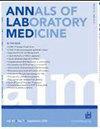Increase in Sapovirus Infection in Korea After the COVID-19 Pandemic: A Six-and-a-half-year Retrospective Study.
IF 3.9
2区 医学
Q1 MEDICAL LABORATORY TECHNOLOGY
引用次数: 0
Abstract
Background Sapovirus is an increasingly recognized cause of acute gastroenteritis (AGE). Despite its significance, data on sapovirus epidemiology and genetic diversity in Korea are limited. Therefore, we examined sapovirus positivity rates over a 6.5-yr period and analyzed the genetic diversity of strains detected in 2022 in Korea. Methods We retrospectively analyzed 204,563 sapovirus multiplex PCR test results from suspected AGE cases collected between 2017 and 2023 at two institutions. Monthly and age-specific positive rates were evaluated. Forty sapovirus-positive samples from 2022 were genotyped using reverse transcription PCR and sequencing. The sequences were compared with those in the National Center for Biotechnology Information Virus database, and a phylogenetic tree was constructed to assess genetic relationships among sapovirus strains. Results The overall sapovirus positivity rate from 2017 to 2023 was 2.2%, with an increasing trend in summer and autumn, except during the coronavirus disease 2019 (COVID-19) pandemic in 2020 and 2021, when sapovirus was rarely detected. Positivity markedly increased in the summer and autumn of 2022 and 2023 following the COVID-19 pandemic. The predominant genotypes in 2022 were GI.1 and GII.3. Phylogenetic analysis revealed genetic diversity among circulating strains. Conclusions This study highlights the rising incidence of sapovirus in Korea, particularly after the COVID-19 pandemic. Despite focusing on genotyping data from a single year, these findings emphasize the need for ongoing surveillance to monitor sapovirus evolution and its public health impact. Additionally, our findings provide essential baseline data for future research into the epidemiology and genetics of sapovirus.COVID-19大流行后韩国病毒感染增加:六年半的回顾性研究
背景札波病毒是引起急性胃肠炎(AGE)的一种日益公认的病因。尽管具有重要意义,但韩国的萨帕病毒流行病学和遗传多样性数据有限。因此,我们检查了6.5年期间的萨帕病毒阳性率,并分析了2022年在韩国检测到的菌株的遗传多样性。方法回顾性分析2017 - 2023年在两所医院收集的疑似AGE病例的204563例腺病毒多重PCR检测结果。评估每月和特定年龄的阳性率。采用反转录PCR和测序方法对2022年40份沙巴病毒阳性样本进行基因分型。将这些序列与美国国家生物技术信息中心病毒数据库中的序列进行比较,并构建系统发育树来评估病毒株间的遗传关系。结果2017 - 2023年总体萨巴病毒阳性率为2.2%,除2020年和2021年2019冠状病毒病(COVID-19)大流行期间很少检出萨巴病毒外,夏、秋季呈上升趋势。在2019冠状病毒病大流行后的2022年夏季和2023年秋季,阳性反应显著增加。2022年主要基因型为GI.1和gi .3。系统发育分析显示了各流行菌株的遗传多样性。结论:本研究强调了韩国病毒发病率的上升,特别是在COVID-19大流行之后。尽管侧重于一年的基因分型数据,但这些发现强调需要持续监测,以监测萨帕病毒的进化及其公共卫生影响。此外,我们的发现为sapovirus的流行病学和遗传学的未来研究提供了必要的基线数据。
本文章由计算机程序翻译,如有差异,请以英文原文为准。
求助全文
约1分钟内获得全文
求助全文
来源期刊

Annals of Laboratory Medicine
MEDICAL LABORATORY TECHNOLOGY-
CiteScore
8.30
自引率
12.20%
发文量
100
审稿时长
6-12 weeks
期刊介绍:
Annals of Laboratory Medicine is the official journal of Korean Society for Laboratory Medicine. The journal title has been recently changed from the Korean Journal of Laboratory Medicine (ISSN, 1598-6535) from the January issue of 2012. The JCR 2017 Impact factor of Ann Lab Med was 1.916.
 求助内容:
求助内容: 应助结果提醒方式:
应助结果提醒方式:


